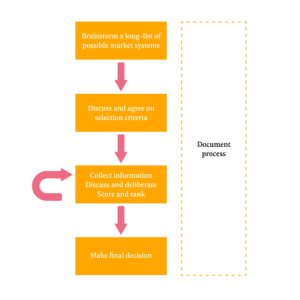PDF Download: Full Market Selection Guidance
In a nutshell: Market Selection enables you to identify market systems that will give you the best opportunity to achieve your goals. It involves explicitly comparing market systems against one another, and requires you to gather information, design criteria and ultimately make decisions on where to focus.
Status: Core Tool
Key principles: Market Selection lays the ground for future participation, given that the position of marginalised groups is one key criterion for selecting market systems. Additionally, Market Selection encourages systems thinking by considering markets from a range of different economic, social and environmental perspectives. Lastly, selecting markets that are more likely to work for women, or provide opportunities for transformational change, brings gender to the foreground from the very beginning.
Preconditions and preparation: It is crucial to Market Selection that information from multiple sources is collected. Ideally the most up-to-date existing studies of key markets can be gathered, and interviews with industry leaders and experts can be arranged prior to Market Selection.
Timelines and resources: With a sufficient level of information, and a knowledgeable team, initial Market Selection can be carried out over several days to a week. The diagram below shows the typical step-by-step process for Market system Selection.
Outputs
The primary output of Market Selection is a shortlist of prioritised market systems, with quantitative scores against the key criteria. Additionally, it is helpful to capture comments on why the final market systems were selected – this documentation can prove useful for proposal writing (to justify the decisions) or mid-term reviews (to reflect on how accurate those assumptions were).
 The long-list of possible market systems may well be informed or directed by the donor or knowledge from past projects. The most important aspect of this process is to choose criteria explicitly and to gather enough information to make an informed final decision. The three crucial factors in any PMSD process are:
The long-list of possible market systems may well be informed or directed by the donor or knowledge from past projects. The most important aspect of this process is to choose criteria explicitly and to gather enough information to make an informed final decision. The three crucial factors in any PMSD process are:
1. Economic opportunity (demand from end markets; potential increase in income/wealth; competitiveness; potential for change)
2. Potential impact on poverty (involvement of target groups; income gains; target group’s share of value; competitiveness of target groups)
3. Gender and social inclusion (role of women/other marginalised groups in the market, potential for transformational change in the market)
Additionally, all projects should include environmental sustainability or the potential to contribute to resilience as a criterion. The weight given to each criterion can change, but it’s important to make it explicit.
Finally, depending on the project’s focus and the country context, it is likely that an additional criterion or two will be added.
Once there is a list of potential sectors, and a set of criteria, then the dedicated team needs to gather information from available sources; discuss and deliberate with informants; and use scoring, weighting and ranking tools to produce a final decision. This is the iterative part of the process – with limited time, there will always be a shortage of information. Some of the key best practices from prior market selection include:
- Consult with different informants in an iterative manner. Allow them to change your thinking, and even potentially your criteria.
- Triangulate and confirm information.
- Use steering questions to focus the discussions.
- Don’t rely on weighting, ranking and scoring too much.
- Don’t underestimate the influence of donor relations.
- Document the process.
Outcomes/behaviour changes
Market Selection mainly leads to internal decisions about the focus of the programme. However, it can also lead to improved relationships with key informants who can be engaged during implementation.